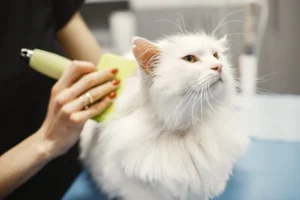Have you ever found yourself standing at the door, calling for your cat to come inside, only to be met with indifference or disdain? You’re not alone. Many cat owners have experienced the frustration of a feline who simply refuses to come indoors. But why does your cat not want to come inside? Let’s explore some possible reasons and solutions.
Struggling with a cat who won’t come inside can be a common issue for many pet owners. Here are some potential reasons why your cat may be resisting coming indoors, as well as some tips for encouraging them to come inside.
1. Fear of the Unknown
Cats are naturally cautious creatures, and they may feel uneasy about entering unfamiliar environments. Imagine if you were in their paws – would you want to step into a place you’re not sure about? Cats rely heavily on their instincts to stay safe, so if they sense something unfamiliar or threatening, they may hesitate to come inside.
One way to help your cat overcome this fear is by slowly introducing them to the indoor environment. Start by creating a safe space near the door where they can explore at their own pace. You can also try leaving the door open for short periods so they can peek inside and get a feel for the space. By gradually familiarizing your cat with the indoor environment, you can help alleviate their fear and encourage them to come inside.
If your cat still seems hesitant, consider setting up comfort items near the entrance, such as their favorite bed or toys. These familiar scents and objects can help create a sense of security for your cat and make the indoor environment more inviting.
2. Comfort and Familiarity
Creating a comfortable and inviting indoor environment is key to encouraging your cat to come inside. Cats are creatures of comfort, and they are more likely to enter a space that feels safe and familiar to them. Make sure your home is cat-friendly by providing cozy resting spots, scratching posts, and interactive toys.
Maintaining a consistent routine can also help your cat feel more comfortable indoors. Cats thrive on predictability, so try to feed them at the same times each day and establish a regular playtime routine. By creating a sense of familiarity and security in the indoor environment, you can make your cat more inclined to come inside.
Additionally, consider investing in a cat door to give your feline friend the freedom to come and go as they please. This can help alleviate any anxieties they may have about entering the house and give them the independence they desire.
Remember, every cat is unique, so it may take some time and patience to help your furry friend feel comfortable coming inside. By understanding their fears and preferences, you can create a welcoming indoor environment that your cat will love.
3. Outdoor Stimulation
When your cat refuses to come inside, it could be due to the alluring outdoor stimulation that captivates them. Outdoor sights, sounds, and smells can provide endless entertainment and exploration, making it harder for your feline friend to leave their little outdoor paradise behind. To entice your cat to come inside, consider creating an environment indoors that mimics some of the outdoor elements they enjoy. Adding a cat tree near a window for bird watching, playing nature sounds, or using cat-safe plants can help satisfy their craving for outdoor stimuli while keeping them safe and comfortable indoors.
4. Behavioral Issues
If your cat consistently avoids coming inside, there may be underlying behavioral issues at play. Anxiety, fear, or even aggression towards other pets or family members can lead your cat to resist indoor living. It’s essential to address these behavior problems with patience and understanding to create a safe and welcoming environment for your cat. Consider consulting with a veterinarian or a professional animal behaviorist to develop a customized plan to help your cat feel more at ease indoors. Providing interactive toys, comfortable hiding spots, and creating a predictable routine can also help alleviate your cat’s reluctance to come inside.
Additional Unique Insight:
Separation Anxiety: Cats can experience separation anxiety, making them anxious when separated from their owners or familiar surroundings. This anxiety can manifest as a reluctance to come inside, as they may fear being away from a safe space or their favorite human. Taking steps to build your cat’s confidence, such as engaging in interactive playtime before transitioning indoors, can help ease their anxiety and encourage them to come inside willingly.
5. Health Concerns
Is your feline friend reluctant to come indoors? It could be due to underlying health issues. Cats, like humans, can experience physical discomfort that may make them avoid certain activities. Arthritis, dental pain, or other health conditions could be causing your cat to resist coming inside. To address this, it’s crucial to take your cat to the vet for a thorough check-up. Your veterinarian can identify any health issues and recommend appropriate treatment to make your cat more comfortable. By addressing these health concerns, you can help your cat feel better and more willing to come inside and spend time with you.
6. Environmental Enrichment
Wondering why your cat prefers the great outdoors to your cozy home? It might be because their indoor environment lacks stimulation and excitement. To entice your cat to come inside, try enriching their environment with interactive toys, scratching posts, cozy beds, and climbing structures. Cats are curious creatures who thrive on mental and physical stimulation, so providing a variety of enrichment options can make your home more appealing to them. Additionally, consider setting up a perch by a sunny window or a bird feeder outside to give your cat something interesting to watch. By enhancing your cat’s indoor environment, you can create a space that is both comfortable and stimulating, encouraging your feline companion to spend more time indoors.
- Hide-and-Seek with Treats: Hide treats around the house to encourage your cat to explore and discover hidden treasures.
- Catnip Toys: Sprinkle some catnip on toys or scratching posts to entice your cat and make indoor play more appealing.
- Vertical Space: Cats love to climb and perch up high, so invest in cat trees or shelves to give them a sense of security and territory.
- Interactive Feeding: Use puzzle feeders or food-dispensing toys to keep your cat mentally engaged and satisfied.
- Outdoor Enclosure: If possible, create a safe outdoor enclosure or catio for your cat to enjoy the sights and smells of the outdoors while staying protected.
7. Training and Reinforcement
Training your cat to come inside on command can be a game-changer. Start by associating a specific sound or phrase with entering the house, like shaking a bag of treats or saying “Inside time!” Consistency is key – reward your cat with treats or praise every time they comply. Reinforce positive behaviors by creating a pleasant experience indoors, with toys, cozy spots, and treats waiting for them. Remember, patience is essential in training your feline friend.
8. Exercise and Play
To address why your cat might not want to come inside, consider their need for exercise and play. Indoor cats need stimulation to burn off excess energy. Ensure your cat has ample play opportunities with toys like interactive puzzles, feather wands, or laser pointers. Set aside dedicated playtime each day to engage with your cat physically and mentally. Providing an enriched environment inside can make them more inclined to come indoors willingly.
Additional Insight: – Consider setting up a DIY indoor obstacle course for your cat to explore and play in, using cardboard boxes, tunnels, and shelves. This interactive environment can keep them entertained and active, making coming inside a more enticing prospect.
9. Seeking Professional Help
If your cat continuously refuses to come inside, it might be time to consult a veterinarian or animal behaviorist. They can help determine if there are any underlying health issues causing your cat’s reluctance or if there are behavioral factors at play. A professional can provide tailored advice and strategies to address the situation effectively. Don’t hesitate to seek expert guidance for the well-being of your furry friend.
10. Interesting Facts about Cat Behavior
- Scratching the Door: Cats may not want to come inside if they see it as a barrier to their territory. They might scratch at the door to mark their scent and assert their ownership.
- Nocturnal Nature: Cats are crepuscular animals, meaning they are most active during dawn and dusk. Your cat might prefer being outside during these times, exploring and hunting.
- Hunting Instinct: Cats have a strong hunting instinct, and being outdoors allows them to fulfill this natural behavior. Your cat may be more reluctant to come inside if they are in the middle of a hunting spree.
- Sunbathing: Cats are known to enjoy basking in the sun for warmth and relaxation. If your cat finds a sunny spot outside, they may choose to stay there rather than come indoors.
For additional information on feline behavior and tips, check out the American Association of Feline Practitioners’ website: https://catvets.com/
Conclusion: Helping Your Cat Feel at Home
Understanding your cat’s behavior when they don’t want to come inside is crucial for creating a safe haven for them. Cats are independent creatures and may prefer the outdoors for various reasons, such as exploring, hunting, or simply enjoying the fresh air. By providing a comfortable indoor environment with cozy hiding spots, engaging toys, and regular playtime, you can help your cat feel at home and more willing to come inside. Remember to always respect your cat’s boundaries and give them the space they need to feel secure.
For an additional unique insight, consider setting up a comfortable outdoor enclosure or cat patio where your feline friend can enjoy the best of both worlds. This allows them to safely experience the outdoors while still being protected from potential dangers.
Remember, every cat is different, so it’s essential to observe your pet’s behavior and preferences to tailor your approach accordingly. By prioritizing your cat’s comfort and well-being, you can create a harmonious living environment where your furry friend feels safe, loved, and content.
Alex, a passionate animal lover, has experience in training and understanding animal behavior. As a proud pet parent to two dogs and three cats, he founded AnimalReport.net to share insights from animal experts and expand his knowledge of the animal kingdom.




